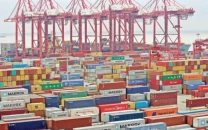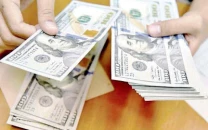PTI govt set to amend SBP Act, give it more autonomy
Will allow central bank to stop printing money for budgetary financing

Representational image. PHOTO: REUTERS
The central bank used to print money to finance the deficit in budgetary spending by the government. This type of money printing was a cause for inflation in the country.
The government is going to amend a relevant “SBP Act…to legally prevent this type of money printing. This will be another institutional reform which will help to control the inflation,” said State Bank of Pakistan (SBP) Governor Reza Baqir.
Baqir expressed these views while speaking to members of the National Executive Committee of the English Speaking Union of Pakistan on Monday.
The central bank would soon propose an amendment to its relevant law to parliament through the Ministry of Law, it was learnt. Earlier, the government agreed with the IMF on making such an amendment to make the central bank a more autonomous financial institution.
To recall, the government has already stopped borrowing from the central bank since July 2019 under the ongoing IMF loan programme worth $6 billion signed in May 2019. The federal and provincial governments have been making such borrowing from commercial banks since July last year.
Pakistan Bureau of Statistics (PBS) reported that inflation increased 12.4% in February compared to a nine-year high of 14.6% in January. With this, the average rate of inflation stood at 11.7% for the first eight months of current fiscal year compared to SBP’s projection of 11-12% for the full year.
Reforms deliver
The central bank has remained confident that the economic reforms introduced under the current IMF programme will continue to deliver, Baqir stated.
Earlier, the central bank had introduced a market-based rupee-dollar exchange rate in May 2019 and increased the benchmark interest rate under the reforms drive. “The new exchange rate mechanism has helped strengthen the rupee,” he said.
The measures have helped to increase the country’s foreign currency reserves by $5.5 billion in the current fiscal year to around $12.5 billion, he pointed out. “The SBP is very confident the reforms will continue to deliver. We are confident inflation will drop further,” he said.
Negative return
Speaking in support of the central bank’s move to raisethe benchmark interest rate to a nine-year high at 13.25% in July 2019, the SBP governor said the rate-hike has helped tame the inflation.
Simultaneously, the high-interest rate has helped a large number of people, especially the retired ones, to realise a higher profit from the investment made in the National Savings Schemes (NSS), he said.
For many people, the return on investment from NSS is the only source of income. However, the rate of return (ie 11%) on such investments remained negative when compared with the prevailing average rate of inflation at 11.7%, he noted.
The high interest rate has also not stopped exporters from making new investment and importing raw material. The central bank offers subsidised financing at the rate of 3% for the import of raw material by the exporters and offers long-term project financing at 5% to textile exporters and 6% to other exporters, he highlighted.
Payment gateway
Baqir stressed that the central bank wants people to reduce their reliance on cash payments and aimed to promote the use of digital payments.
In this regard, the central bank would soon launch a payment gateway.
Published in The Express Tribune, March 3rd, 2020.
Like Business on Facebook, follow @TribuneBiz on Twitter to stay informed and join in the conversation.



















COMMENTS
Comments are moderated and generally will be posted if they are on-topic and not abusive.
For more information, please see our Comments FAQ